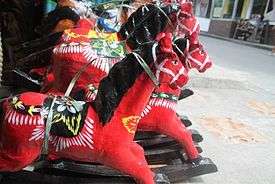Taka (paper mache)
Taka refers to paper mache made using carved wooden sculpture used as a mold. The craft originated in the town of Paete, Laguna in the Philippines.[1]

History
Taka was pioneered by Paete local, Maria Piday. During Christmas, Piday was in charge of the church's decorations. The wooden angels and cherub was heavy causing the carvings to fall. Piday devised the lightweight taka paper mache as an alternative to the wooden sculptures. Piday was also a maker of local toys such as the yoyo and the small acrobat hand puppet. Taka eventually became folk art and was sold to nearby towns for festivals. In the 1970s, Tere Afuang, a knowledgeable practitioner of the craft, popularized the craft.[1]
Taka-making
A takaan, a carved wooden sculpture, is used as a mold in making taka. Brown craft paper is used as a final layer for taka made for export. This provides a thicker base and smoother finish for the craft. Taka is also painted. The traditional way of painting a taka is to use primary colors, add simple flower motifs and use repetitive lines and shapes. Gold finish, usually used in angel, reindeer and huge taka is accomplished by using gilded paper.[1]
Subjects of Taka
Common and traditional subjects of taka include the manok, kabayo, kalabaw, dalaga (chicken, horse, carabao, maiden) which is made primarily for local use. Due to exposure and migration of Paete residents to Manila and abroad, European-influenced paper mache toys began to be made for export to other countries, such as Germany. Taka images now include those of Santa Claus, reindeer, giraffes, and other subjects that are in demand.[1]
References
- Datuin, Flaudette May; et al. (1997). "Paete:A Living Fusion of Art & Society". Art and Society. Diliman, Quezon City: University of the Philippines. pp. 240–241. ISBN 971-91907-01.